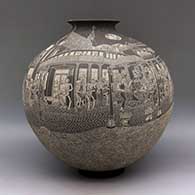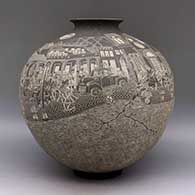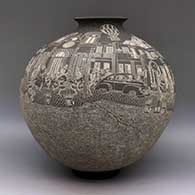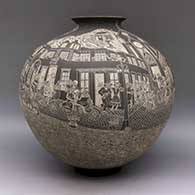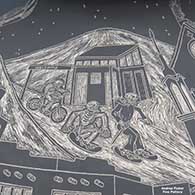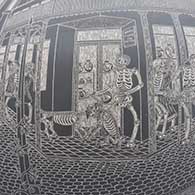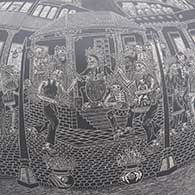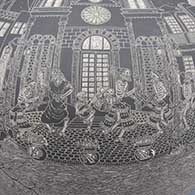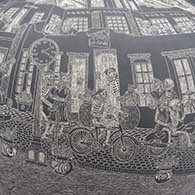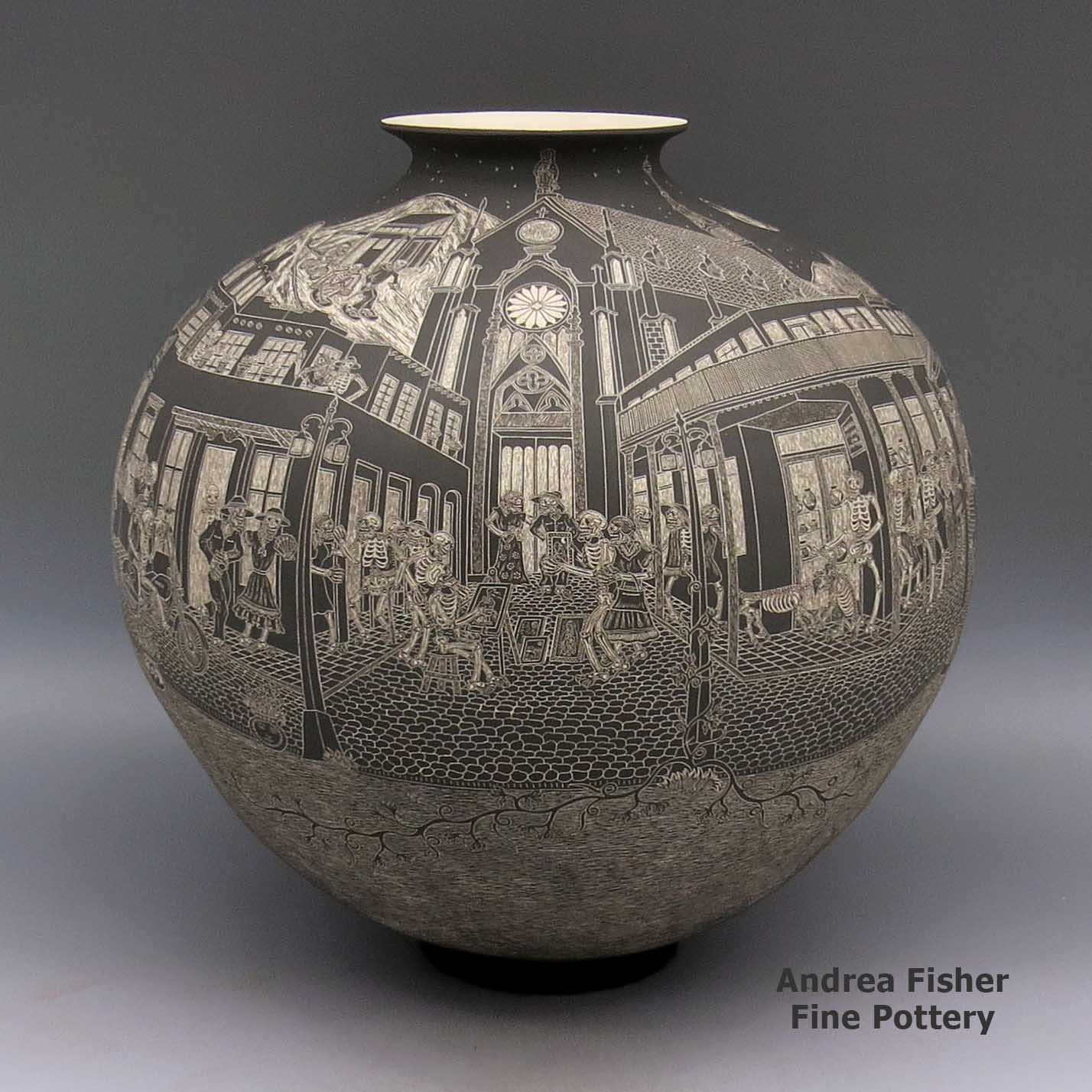
Mata Ortiz and Casas Grandes
$ CALL
zzcg2j310
Large black and white jar with flared rim and sgraffito Night of the Dead in Santa Fe design
16 in L by 16 in W by 17 in H Measurement includes stand
Condition: Excellent
Signature: H. Javier Martinez Mendez Gabriela Perez de Martinez
Date Created: 2022
Sale Price: $9900
Tell me more! Buy this piece!
(505) 986-1234 - www.andreafisherpottery.com - All Rights Reserved
Hector Javier
Martinez
Mata Ortiz andCasas Grandes
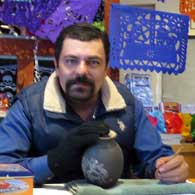
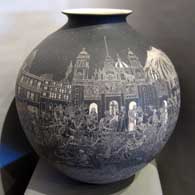
Born in 1984, Hector Javier Martinez sprang onto the Mata Ortiz pottery scene around 2008 with his distinctive style of black and white pots incised with Day of the Dead and Night of the Dead motifs. Those designs resulted from a comment made to him by Steve Rose (a well-known American pottery dealer).
Employed as an auto mechanic and gardener just to make ends meet while he figured out the pottery making business, Javier had asked what Steve thought he needed to do in order to make pottery his real day job. Steve replied, "Time for something different." A few years later Javier earned a First Place award at the 2013 Concurso Ceramica de Mata Ortiz for one of his Day of the Dead pots. Then in 2014 he earned the Presidencial Award at the Premio Nacional de la Ceramica in Tlaquepaque, Mexico. He'd submitted a large black-on-white olla incised with Mexico City sights and his Night of the Dead theme (the pot pictured above). Since then we have seen his pots with Day of the Dead and Night of the Dead motifs on them with backgrounds from Paris, Santa Fe, San Francisco, Venice, Mata Ortiz and New York City.
Javier told us he first learned how to make pottery from his mother, but her style was very different from what he found in Mata Ortiz. He had to learn all over again, using local materials and different processes and tools.
In the beginning, his subjects were religious (the Virgin of Guadalupe, priest images, etc.) and the designs were all painted on his pots. It was more than a decade ago that he and Gabriela produced their first black-and-white sgraffito Day of the Dead/Night of the Dead pots together. The style took off immediately and they haven't looked back since, although they have branched out into polychromes and now decorate bowls and plates, too.
Today, Javier is producing all kinds and sizes of pots with his signature Day of the Dead and Night of the Dead motifs. However, with his success has come competition and knockoffs. That said, the detail of his work sets him well apart and working with Gabriela has introduced some new elements into their Dia de los Muertos collection of designs, adding curlicues and other graphic elements, sometimes in Javier's designs and sometimes around the base and in a wide band below the rim.
Javier and Gabriela have four sons, ten years between youngest and oldest (although Javier says he wants another). He says his inspiration comes from his culture and music. Gabriela concurred with that saying that when he's working on a large pot, he might as well be living as a character on the pot.
Javier and Gabriela usually come to visit with us at Andrea Fisher Fine Pottery in Santa Fe just before Dia de Los Muertos (November 1).
Gabriela Perez
de Martinez
Mata Ortiz andCasas Grandes

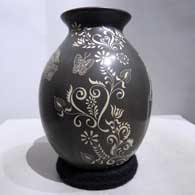
Gabriela Perez de Martinez was born in 1983. About 20 years later she met and fell in love with Hector Javier Martinez. At the time he was doing scattered odd jobs around Mata Ortiz as a car mechanic and gardener, trying to make ends meet while he spent his spare time trying to figure out how to make pottery the Mata Ortiz way. Their first son (Gabriel) was born before Javier got it right, then his pottery business took off about the same time Hector Javier Jr. (their second son) was born. Gabriela got involved and learned the whole process from Javier because he just couldn't keep up with demand. At the same time, she brought a feminine touch to his work and in this time of increased competition and knock-offs, that feminine touch is rewarding them with new designs that showcase the best that both Gabriela and Javier bring to their craft.
Gabriela says she has been making pots for about 10 years after having been taught how by her husband. It's Gabriela who adds the sgraffito butterfly, flower, vine and curlicue designs to their pieces. She also fills in some of the fine details for Javier.
Gabriela told us she gets her inspiration from Nature, and while Javier says he'd like another son, Gabriela assures us that four boys is more than enough.
Mata Ortiz and Casas Grandes

The macaw pens at Paquimé
Casas Grandes is both a municipality and an archaeological district in northern Chihuahua State, Mexico. The archaeological district includes the pre-historic ruins of Paquimé, a city that began to build around 1130 AD and was abandoned about 1450 AD. Archaeologists are uncertain as to whether Paquimé was settled by migrants from the Mogollon/Mimbres settlements to the north or by Anasazi elite from the Four Corners region in the United States or by others. Over the years Paquimé was built into a massive complex with structures up to six and seven stories high with multiple Great Houses in the surrounding countryside. Today, the site is a UNESCO World Heritage Site.
Mata Ortiz is a small settlement inside the bounds of the Casas Grandes municipality very near the site of Paquimé. The fortunes of the town have gone up and down over the years with a real economic slump happening after the local railroad repair yard was relocated to Nuevo Casas Grandes in the early 1960's. The town was in steady decline until Juan Quezada, a poor farmer who gathered firewood in the area of the archaeological site, was inspired by fragments of ancient Paquimé pottery and even older fragments of Mimbres forms with bold black-on-white designs littering the ground to learn more.
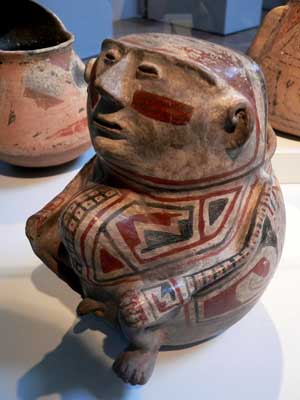
Ramos Polychrome effigy pot from Paquimé
Quezada was successful in his quest to learn to recreate the ancient process using slightly more modern techniques (although no one in the present tradition uses a potter's wheel). He learned to use sand and other coarse materials for temper. He discovered that dried cow dung made an excellent and inexpensive firing fuel. Instead of using gourds for smoothing he substituted broken hacksaw blades. Instead of using yucca fiber brushes for painting he learned to make brushes with human hair. He persevered in his efforts and by 1971 had produced a kind of polychrome pottery. Since then, most pottery-making in the area has used innovations in the design and decoration of the pots but the materials and the basic crafting of the process have remained the same.
By the mid-1970s, Quezada had attracted a significant number of traders and his work was becoming a commercial success. That is when he began teaching his techniques to his immediate family. They in turn taught other family members, friends and the younger generations. Both women and men were included from the beginning.
Originally called Casas Grandes pottery in the early years of its production, the potters of this tiny village have made such an impact on the pottery communities, including many awards and special recognition from the Presidents of Mexico, that Mata Ortiz pottery is now becoming known around the world.
Today, pottery production has changed the village in many ways as there is now electricity, plumbing, vehicles and more for the residents. Virtually everyone in the small town (2010 population: 1,182) makes their living by working in some part of the pottery-making process, from potters to clay-gatherers to firewood collectors to traders.
Mata Ortiz pottery incorporates elements of contemporary and prehistoric design and decoration, and each potter or pottery family produces their own distinctive, individualized ware. Young potters from surrounding areas have been attracted to the Mata Ortiz revival and new potting families have developed while the art movement continues to expand. Without the restraints of traditional religious practices or gender constraints, a vibrant flow of new ideas has enabled the pottery of Mata Ortiz to avoid the derivative repetition common to virtually all folk art movements. This blend of economic need, gender equality, cultural expression and artistic freedom has produced a unique artistic movement in today's community.
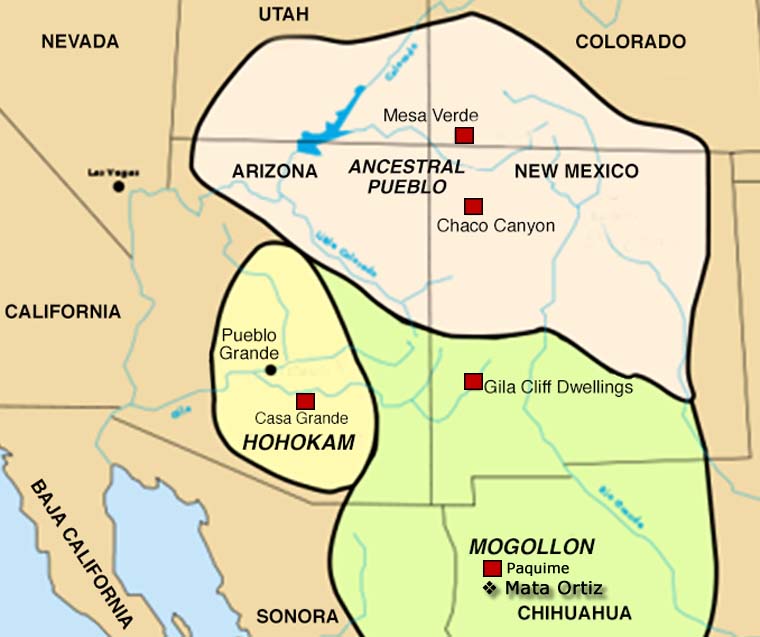
Lower photo is courtesy of David Monniaux, Creative Commons Attribution-Share Alike 3.0 Unported License
Day of the Dead

Mata Ortiz
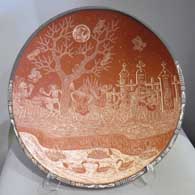
Mata Ortiz
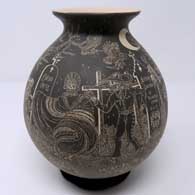
Mata Ortiz
The Day of the Dead, El Dia de los Muertos, is a holiday celebrated in Mexico where ancient Aztec rituals going back more than 2,500 years are merged with Catholic beliefs brought by the Spaniards in the 1500s. The holiday is about honoring the ancestors with food, drink, parties and other activities designed to include the ancestors' spirits in today's daily life. Families also set up ofrendas (private altars) to honor their ancestors.
Death is considered an integral part of the continuum of life and, as such, is not to be feared. Celebrations occur November 1 (All Saints Day) when adult spirits come to visit, and November 2 (All Souls Day) when families go to the cemetery to decorate the graves of their loved ones. This is a very colorful holiday with marigolds, cardboard skeletons, sugar skulls, incense and tissue paper decorations in riotous colors everywhere.
Depictions of Day of the Dead activities is a motif explored by several renowned potters from the village of Mata Ortiz in Chihuahua, Northern Mexico. Premier among them is Hector Javier Martinez who originated the style in 2008 after searching for "something different" to help him secure pottery making as a vocation. He has since won several major awards for his Day of the Dead (and Night of the Dead) pottery, the very prestigious Presidencial Award from the Mexico National Ceramics Concourso in Tlaquepaque among them. Alfredo Rodriguez, Diana Loya, Martin Corona, Adrian Corona and Emiliano Rodriguez are some of the other Mata Ortiz artists using Day of the Dead and Night of the Dead motifs as inspiration for their own creations.
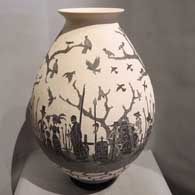
Mata Ortiz
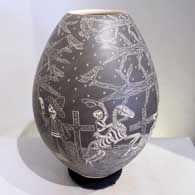
Mata Ortiz
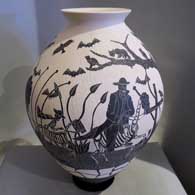
Mata Ortiz
Copyright © 1998-2024 by


